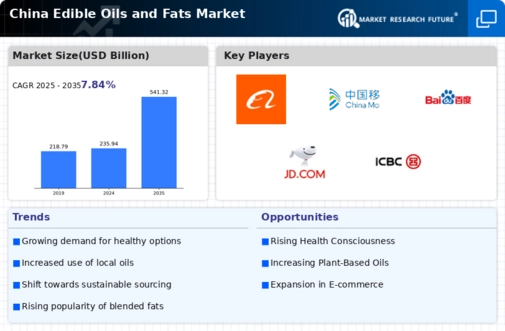Increasing Urbanization
The rapid urbanization in China is driving the demand for convenience foods, which often utilize various types of edible oils and fats. As more individuals migrate to urban areas, their dietary preferences shift towards ready-to-eat meals, which typically contain higher levels of processed oils. This trend is reflected in the edible oils and fats market, where the consumption of palm oil and soybean oil has surged, accounting for approximately 60% of total oil consumption in urban regions. The growing population in cities is likely to further increase the demand for these oils, as urban dwellers seek quick and easy meal solutions. Consequently, the edible oils-fats market is expected to expand significantly, driven by the need for oils that cater to the fast-paced lifestyle of urban consumers.
Impact of Culinary Trends
Culinary trends in China are evolving, with a growing interest in diverse cooking styles and international cuisines. This shift is impacting the edible oils-fats market, as consumers experiment with various oils that are integral to different culinary traditions. For example, the use of sesame oil in Asian cooking and avocado oil in Western dishes is becoming more prevalent. This diversification in cooking practices is likely to increase the demand for a wider variety of oils, as consumers seek to enhance their culinary experiences. Market analysis indicates that specialty oils are projected to grow at a rate of 10% annually, reflecting the influence of these culinary trends. As consumers continue to explore new flavors and cooking methods, the edible oils-fats market is expected to adapt and expand to meet these evolving preferences.
Rising Disposable Incomes
The increase in disposable incomes among the Chinese population is positively influencing the edible oils-fats market. As consumers have more financial resources, they tend to opt for higher-quality oils, such as olive oil and specialty oils, which are perceived as healthier options. Reports indicate that the premium segment of the edible oils-fats market has grown by approximately 15% annually, reflecting a shift in consumer preferences towards quality over quantity. This trend suggests that as disposable incomes continue to rise, the demand for diverse and premium edible oils will likely increase, further propelling the market's growth. The edible oils-fats market is thus positioned to benefit from this economic uplift, as consumers are willing to invest in healthier and more diverse cooking oils.
Growing Awareness of Nutrition
There is a notable increase in consumer awareness regarding nutrition and health benefits associated with different types of fats and oils. This growing consciousness is influencing purchasing decisions in the edible oils-fats market, as consumers become more discerning about the nutritional profiles of the oils they choose. For instance, oils rich in omega-3 fatty acids, such as flaxseed oil, are gaining popularity among health-conscious consumers. Market data suggests that the demand for oils with specific health benefits has increased by approximately 20% in recent years. This trend indicates that consumers are actively seeking oils that align with their health goals, thereby driving innovation and diversification within the edible oils-fats market. As awareness continues to grow, it is likely that the market will see an expansion in the range of health-oriented products available.
Government Regulations and Standards
The Chinese government has implemented various regulations and standards aimed at ensuring food safety and quality in the edible oils-fats market. These regulations include stringent labeling requirements and quality control measures that manufacturers must adhere to. Compliance with these standards is essential for market players, as it not only affects product acceptance but also consumer trust. The enforcement of these regulations has led to a consolidation of the market, where established brands with the capability to meet these standards are likely to thrive. This regulatory environment may also encourage innovation in the edible oils-fats market, as companies seek to develop healthier and safer products to comply with government mandates. Overall, these regulations are expected to shape the competitive landscape of the market, influencing both production and consumption patterns.
















Leave a Comment